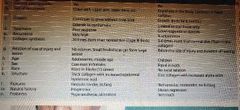![]()
![]()
![]()
Use LEFT and RIGHT arrow keys to navigate between flashcards;
Use UP and DOWN arrow keys to flip the card;
H to show hint;
A reads text to speech;
25 Cards in this Set
- Front
- Back
|
Pleural effusion |
Accumulation of fluid in the pleural space can be a transudate<25g/L and exudate >35g/L |
|
|
Types of effusion |
Blood in space is haemothorax, pus in space is empyema, chyle in space chylothorax Haemopneumothorax |
|
|
Causes of effusions |
Transudates(increased venous pressure) : cardiac failure, consteictive pericarditis, fluid overload, or hypoproteinemia(cirrhosis, nephrotic syndrome, malabsorption) also in hypothyroidism and Meig's syndrome(right pleural effusion and ovarian fibroma) |
|
|
Causes of pleural effusion |
Exudates increased leakiness of pleural capillaries secondary to infection, inflammation or maligancy pneumonia, TB, pulmonary infarcts, rheumatoid arthritis, SLE, Bronchogenic carcinoma, malignant metastases, lymphoma, mesothelioma, lymphangitis carcinomatosis |
|
|
Differential diagnosis of epigastric pain and one bout of vomiting |
Drug intoxication, Uremia, DKA Appendicitis Cholecystitis Pancreatitis Peptic ulcerations/acute gastritis Peritonitis Biliary colic Ureteric colic Gastroenteritis |
|
|
Surgery for perforated peptic ulcer |
Suture the perforation plus an omental patch= Rosoe Graham Operation through an upper midline incision |
|
|
DRE with severe pain |
Anal fissure Prosatitis Anorectal abscess Pelvic abscess Colon cancer Ulcerative colitis |
|
|
RUQ mass with fever |
Amoebic liver disease Empyema of the gallbladder HCC Metastastic liver cancer Tietze in female Liver masses will move with respiration |
|
|
Increasing tiredness plus abdominal discomfort |
Caricnomas gastric colon cecal Bleeding peptic ulcers Bleeding hemorrhoids Chronic kidney disease Malnutrition chronic liver disease Chemotherapy or surgery wirh hematinics Treat underlying causes and add hematinics |
|
|
Classification of surgical wounds |
Clean wounds(Excisions, Herniorrhaphy, brain, joints, heart, transplant, infective rate less than 2%) Clean contaminated( Appendicectomy, bowel surgeries, gallbladder, biliary and pancreatic) Contaminated wound(acute abdominal condition, open fresh accidental wounds) Dirty infected wound(Abscess, Pyocele, Empyema gallbladder, Fecal peritonitis) |
|
|
Stages of wound healing |
Stage of inflammation Stage of granulation tissue formation and organisation Stage of epithelialisation Stage of scar formation and resorption Stage of maturation |
|
|
What is a scar |
Disorganised contains Type 3 collagen itchy raised hard and pink that is immature, mature scars contain Type 1 collagen Soft supple pale no itch |
|
|
Hypertrophic scar and Keloid |
More Type 3 collagen than type 1 collagen mature scar |
|
|
Types of scars |
Mature scar: Paler, acellular, softer, flat, with reduced blood vessels and fibroblasts without itching Hypertrophic scar: excess scar will not extwnd beyond the margin of the original wound develops 1 to 3 months after trauma improves spontaneously Keloid persistent excessive growth of scar beyond its margin into adjacent skin presternal area commonest |
|
|
Treatment of a keloid |
Steroid injections Laser therapy and is genetically predisposed |
|
|
Treatment of hypertrophic scar |
Need comoression garments Triamcinolone injection |
|
|
Difference between Keloids and Hypertrophic scars |

|
|
|
Obstructive jaundice differentials |
Head of Pancreas Ca Mirrizi Impacted gallstone Periampullary carcinoma Intracanicular cholstasis from fibrosis Cholangiocarcinoma Periaortic lymphadenopathy |
|
|
Most common causes of meningitis in adults |
Neisseria meningitides Streptococcus penumoniae Haemophilus influenza Mycobacterium tuberculosis Staphylococcus aureus Herpes virus Toxoplasma Cryptococcus neoformans |
|
|
Medications for meningitis |
Ceftriaxone IV 2 to 4 grams and Vancomycin IV 15mg/kg Allergic to penicillin Clindamycin and Chloramohenicol |
|
|
Prophylqxis for meningitis |
Ciprofloxacin oral or Ceftriaxone IM |
|
|
Indications for Lumbar puncture |
Subarachnoid hemorrhage, Inflammatory process, CNS Infection, Intrathecal anesthesia, Spinal anesthesia, to relieve hydrocephalus |
|
|
Contraindications for lumbar puncture |
Raised intracranial pressure, Bleeding diathesis Cardiorespiratory compromise Infection at site of needle insertion |
|
|
Signs of increased ICP |
Vomiting, severe headache, reduced level of consciousness, falling pulse, rising BP, focal neurology, papilloedema |
|
|
Complications of LP |
Post LP headache Hemorrhage Paraplegia Infection |

